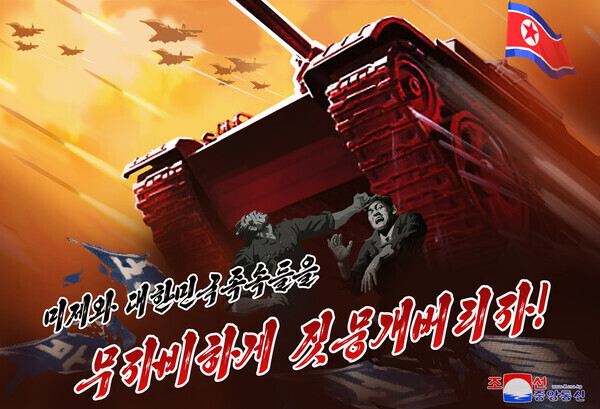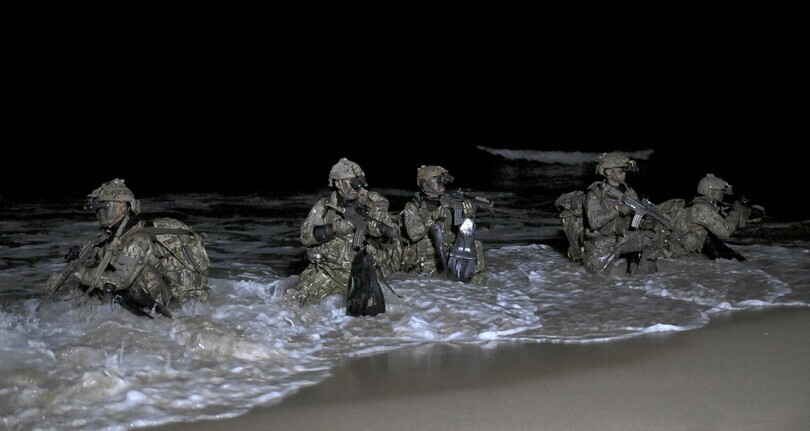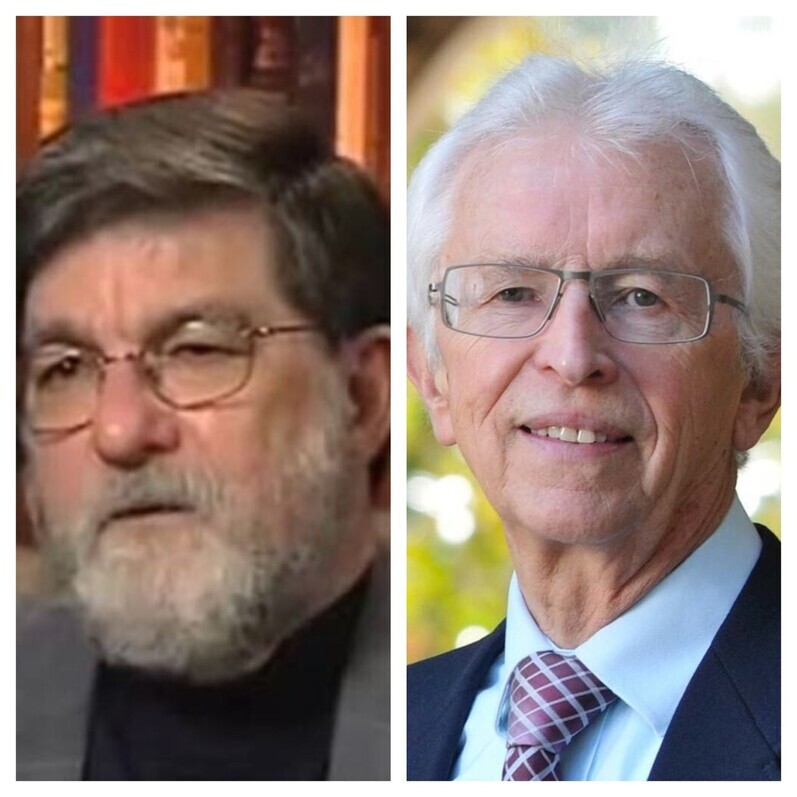hankyoreh
Links to other country sites 다른 나라 사이트 링크
As fears of second Korean War swirl, is Yoon the last one left believing the myth of deterrence?

Two US experts on North Korea, Robert Carlin and Siegfried Hecker, recently sparked concern over the possibility of war on the Korean Peninsula.
In a piece titled “Is Kim Jong-un Preparing for War?” published on the US-based North Korea news and analysis website 38 North on Jan. 11, the two scholars warned that the situation in the Korean Peninsula is similar to that of early June 1950, right on the brink of the Korean War, claiming that “Kim Jong-un has made a strategic decision to go to war.”
This claim has been followed by lively debate among various government officials and North Korea experts in both the US and South Korea about the real-life prospects of a kinetic conflict erupting on the peninsula. Those who believe that war will actually break out remain in the minority.
Robert Gallucci, who formerly served as the US State Department special representative on the North Korean nuclear issue and a key figure behind the 1994 Agreed Framework between North Korea and the US, warned, “We should at least entertain the thought that nuclear war could break out in Northeast Asia in 2024.”
Most North Korea experts and government officials from the US and South Korea alike believe that there is a very slim possibility of war breaking out, the lion’s share agreeing that while it seems almost impossible that the two Koreas will engage in an all-out war, accidental military clashes may occur.

In a radio interview with KBS on Jan. 16, South Korea’s minister of national defense called the rampant claims about war breaking out on the Korean Peninsula “overexaggerated.”
He went on to ask, “If North Korea really intended to go to war, would it be able to export millions of artillery shells to Russia?”
The ROK-US Combined Forces Command maintains a list of indicators for predicting and preparing for hostilities and surprise attacks by North Korea. The list picks indicators relevant to the Korean Peninsula from a matrix compiled by the US military, which is based on worldwide data on studies of past wars.
The list organizes various activities into certain groups. For example, movement of mechanized and armored units to the front-line area, increased flight training of aircraft, increased military communication activities, and increased stockpiling of military supplies are deemed to be preparations for war.
In particular, indicators that are closely related to war are categorized as emergency indicators and managed separately.

South Korean and US intelligence agencies monitor North Korea 24/7, and when they receive unusual information related to a certain indicator, surveillance of that particular signifier is bumped up.
When the military says that “indicators are elevated,” it means that several war-related activities have been identified in North Korea and are therefore being monitored intensively.
South Korea’s defense minister declared that fears of war breaking out on the Korean Peninsula are being exaggerated since there have been no unusual signs according to the list of indicators.
In order for a military to prepare for war, it must greatly increase its stockpiles of munitions, such as artillery shells. However, North Korea has been exporting artillery shells to Russia, instead of stockpiling them for its own use. Even though North Korea is continuing with its aggressive rhetoric, it seems they are not preparing for a real-world war.

Despite such reassurances, many are still worried about a war erupting.
In an editorial titled, “As North Korea’s threat grows, ignoring it is not working,” the Washington Post’s editorial board wrote, “The United States can hope that Mr. Kim’s recent provocations amount to just more bluster. But the Biden administration should plan as though they are more serious.”
The match struck by Carlin and Hecker has grown into a flame not easily stifled due to their status as two of the most renowned US experts on North Korea and the North Korean nuclear problem.
“It’s difficult to ignore an analysis put forward by Carlin and Hecker, of all people,” is the view adopted by many North Korea experts in the US and South Korea, as well as among government officials.
New York Times columnist Nicholas Kristof wrote in an opinion piece on Jan. 17: “I’ve seen many false alarms since I began covering and visiting North Korea in the 1980s. I wouldn’t write about this latest warning except that it comes from two particularly credible experts.”

Carlin worked for the CIA from 1971 to 1989 as an analyst. He started working on North Korea issues in 1974, and kept an eye on the country for the next 50 years or so.
In 1989, Carlin started working in the US Department of State, where he served as the chief of the Northeast Asia Division in the Bureau of Intelligence and Research until 2002, as well as serving as the senior policy adviser to the special ambassador for talks with North Korea.
From 2002 until 2006, he served as a senior policy adviser at the Korean Peninsula Energy Development Organization, which built light water reactors in Sinpo, North Korea.
Since February 1996, he has traveled to North Korea 30 times, even escorting then-Secretary of State Madeleine Albright’s visit to Pyongyang in October 2000. He has been involved in almost every dialogue and negotiation made between the US and North Korea since the 1990s.
When Cho Tae-yong, the current head of South Korea’s National Intelligence Service, was serving as the first vice minister of foreign affairs, he once said that Carlin was “the person who has read the Rodong Sinmun more than anyone else in the US.”
Meanwhile, Hecker is an internationally recognized nuclear physicist in the fields of plutonium science, nuclear weapons policy, and nuclear security. He worked at and served as director of Los Alamos National Laboratory in the US.
The laboratory, founded in 1943, is a state-owned laboratory within the US Department of Energy. Back when it was founded, Robert Oppenheimer served as director and rounded up world-renowned scientists such as Niels Bohr, Enrico Fermi, and Richard Feynman to work on the Manhattan Project, which resulted in the production of the first atomic bomb.
During 2004 and 2010, North Korea invited Hecker to the country to inspect the uranium enrichment facilities and its Yongbyon nuclear facility seven times, as they were well aware of his substantial career.

The harsh words exchanged between the two Koreas, in addition to military overreactions, which have been taking place since late last year, serve as a backdrop to the escalating threat of war on the Korean Peninsula.
During an enlarged plenary meeting of the Workers’ Party of Korea Central Committee, North Korean leader Kim Jong-un declared that the relations between the two Koreas “have been completely fixed into the relations between two states hostile to each other,” and that “reunification can never be achieved.”
He also emphasized the need to prepare “for a great event to suppress the whole territory of south Korea by mobilizing all physical means and forces including nuclear forces in contingency,” in case of an emergency.
North Korea's belligerent rhetoric since the end of 2023 has fanned the flames of speculation that a war on the Korean Peninsula may break out at any moment.
With heightened tensions between the two Koreas continuing through the beginning of the new year, the White House and the Department of State, while continuing sanctions on North Korea, are urging Pyongyang to return to the table of diplomacy.
On the other hand, South Korea’s President Yoon Suk-yeol, the Ministry of Unification, and the Ministry of Defense are emphasizing a definitive approach that calls for “an eye for an eye,” and refusing to bring up dialogue as a resolution.
The Yoon administration believes that North Korea’s bellicose rhetoric is a part of their psychological warfare aimed at stirring up conflict within South Korea before the April general election. They claim that the people of South Korea should stand together with the government in defiance of North Korea’s attempts at deception, propaganda and provocations.
In their column, Carlin and Hecker also emphasize how South Korea and the US have fallen for the mythologization of deterrence.
"Washington and Seoul cling to the belief that their alliance backed by 'ironclad' deterrence will keep Kim on the status-quo trajectory, perhaps with some minor provocations,” they write.
They warn that the “oft-stated conviction that if the North attacks, the counterattack will totally destroy the North Korean regime” could indeed prove “fatal” in our current situation. If a conflict does arise, they say that “even an eventual US-ROK victory in the ensuing war will be empty. The wreckage, boundless and bare, will stretch as far as the eye can see.”
Our key focus must be to avoid a war, not to win one.
By Kwon Hyuk-chul, staff reporter
Please direct questions or comments to [english@hani.co.kr]

Editorial・opinion
![[Guest essay] Preventing Korean Peninsula from becoming front line of new cold war [Guest essay] Preventing Korean Peninsula from becoming front line of new cold war](https://flexible.img.hani.co.kr/flexible/normal/500/300/imgdb/original/2024/0507/7217150679227807.jpg) [Guest essay] Preventing Korean Peninsula from becoming front line of new cold war
[Guest essay] Preventing Korean Peninsula from becoming front line of new cold war![[Column] The state is back — but is it in business? [Column] The state is back — but is it in business?](https://flexible.img.hani.co.kr/flexible/normal/500/300/imgdb/original/2024/0506/8217149564092725.jpg) [Column] The state is back — but is it in business?
[Column] The state is back — but is it in business?- [Column] Life on our Trisolaris
- [Editorial] Penalties for airing allegations against Korea’s first lady endanger free press
- [Editorial] Yoon must halt procurement of SM-3 interceptor missiles
- [Guest essay] Maybe Korea’s rapid population decline is an opportunity, not a crisis
- [Column] Can Yoon steer diplomacy with Russia, China back on track?
- [Column] Season 2 of special prosecutor probe may be coming to Korea soon
- [Column] Park Geun-hye déjà vu in Yoon Suk-yeol
- [Editorial] New weight of N. Korea’s nuclear threats makes dialogue all the more urgent
Most viewed articles
- 1Behind-the-times gender change regulations leave trans Koreans in the lurch
- 2South Korean ambassador attends Putin’s inauguration as US and others boycott
- 3Yoon’s revival of civil affairs senior secretary criticized as shield against judicial scrutiny
- 4Family that exposed military cover-up of loved one’s death reflect on Marine’s death
- 5Hybe-Ador dispute shines light on pervasive issues behind K-pop’s tidy facade
- 6Japan says its directives were aimed at increasing Line’s security, not pushing Naver buyout
- 7[Editorial] New weight of N. Korea’s nuclear threats makes dialogue all the more urgent
- 8[Guest essay] Preventing Korean Peninsula from becoming front line of new cold war
- 9Yoon’s broken-compass diplomacy is steering Korea into serving US, Japanese interests
- 10U.S. band that performed in N. Korea looking forward to going back